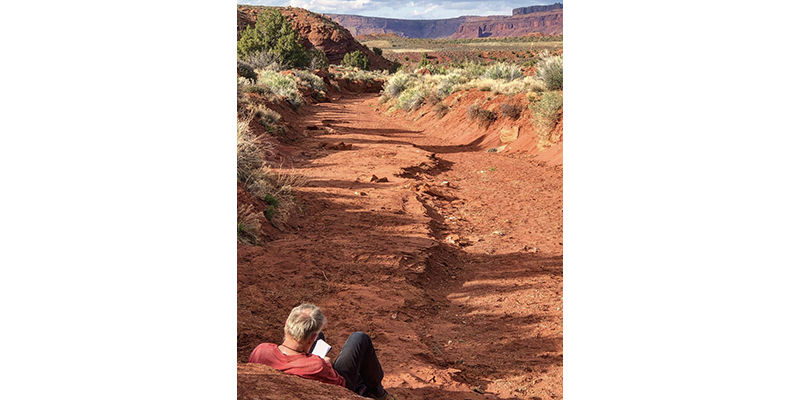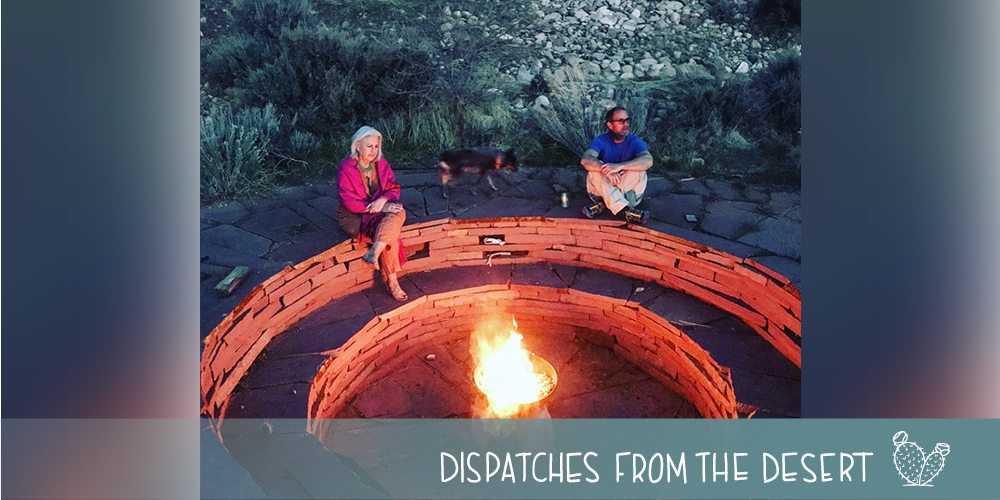25 April 2020
Castle Valley, Utah
he Moab liquor store closed on Friday after one of its employees tested positive for COVID-19. It is being cleaned by a private company contracted by the Utah Department of Alcoholic Beverages to professionally sanitize and disinfect the store.
A record 48 residents of Moab and Castle Valley were tested on Friday. My husband Brooke was among them having visited the liquor store on Monday, the last day the employee worked the counter. He will know within the week whether or not he has been exposed. As a family unit, Brooke, my brother Hank and I are now in our third self-quarantine. Such is the nature of these emotional and physical waves that come with this pandemic.
The nurse who gave Brooke the test told him Moab has been smart having declared a state of emergency on March 12, 2020, among the earliest of Utah towns to sound the alarm for the coronavirus. On March 13, all city buildings, restaurants, and hotels were closed. And by March 28, Arches and Canyonlands National Parks were also closed.
What happened to Jackson Hole, Wyoming, Vail, Colorado, and Sun Valley, Idaho, all tourist towns where the coronavirus came into these rural communities, Moab has been able to avoid. But now, with a reopening of Moab on May 1, residents are worried. The thought of a full town of jeeps, vans, campers, trailers, and mountain bikers from all over the country clogging Main Street again, not to mention the backcountry, is frightening to not only the health care workers at the Moab Regional Hospital, to but to all of us who live here.
My father and his wife are sheltering in place at home in St. George where the city of Dixie has adopted a new “Stay Brighter Campaign” from April 30 to May 30. Initiated by the St. George’s Leisure Services Department, residents are invited to participate in a month-long positivity challenge. The campaign includes a 60-minute daily challenge “that encourages citizens to stay active, stay kind, and stay smart every day with 20-minutes allotted for each of the three disciplines.” To stay active you could go on a walk or ride a bike; to stay kind you could write a letter to your grandparents or make a casserole for your neighbors; to stay smart you could read a book.
Michelle Graves, St. George Deputy Director of Arts and Events, says “We want to continue to spread joy and to work together – though we are physically apart…We encourage our citizens to be a positive change in our city.”
I’m afraid the People’s Republic of Castle Valley is not so chipper or disciplined. Most of us moved here in the outback east of Moab to be alone. Campaigns of forced positivity and discipline wouldn’t really catch fire in our community. We look forward to the annual gourd festival in the fall which favors the lewd and irreverent rather than the uplifting. Although the parade of tractors driven by local gourd goddesses is inspiring.
However, the Moab-Times Independent in their April 24th editorial did ask the question, “How are you doing?” This inquiry based on the fact that Grand County leads the state in job losses on a per capita basis.
They follow the headline with three more questions: “What are you doing to get through the day? Are you coping or unraveling? Are you ready to open up and let fate do its thing or do you think our community should stay closed for a few more weeks?”
I like the pragmatic spirit of Moab, direct, no nonsense, and a bit skeptical of too much enthusiasm. We’ve earned the lines on our sunbaked faces in Grand County. There’s a lot of wind out here as evidenced by arches, windows, and spires of stone.
As my father said when we told him we were moving to Castle Valley, “If you’re off of I-15 you’re going nowhere.” That was our point.

Here are my answers:
The way I am getting through the day is sheltering in place with my husband and brother and three dogs in Castle Valley with room to roam and breathe. I am writing.
I am still working, teaching remotely. And I am keeping in touch with family and friends. What is keeping me sane (if I may be so bold to imply that I am…) is walking in the desert, taking in the beauty, watching spring unfold. At night, we have been watching “The Leftovers.” We have created our own viewing context of COVID-19.
I am coping and unraveling, at once. It feels like we are out to sea being carried further and further away from shore by unexpected waves.
None of us in this household of three are ready to return to life as it once was – in fact, we don’t think it is possible. I think it will take a long time to begin to understand the ways this pandemic pause has altered us. What is essential and non-essential from workers to values to how we spend our time feels like a beginning point. And we have not begun to comprehend what losing 52,000 Americans and a rising death count means to us. As of yet, there has been no public grieving, no collective rituals to honor the dead. Like many, I am still in the throes of work and haven’t had the luxury of time to process this “new normal.” Nothing feels normal. No, I am not ready “to open up” – the consensus around our breakfast table is we all want to stay in place until May 31. None of us believe this virus is going to magically disappear anytime soon.
How would you respond to these three questions? I can imagine answers would vary based on individual circumstances: health, job security, profession, privilege, class, race, and gender; and also, whether or not you have children at home. Or if you are alone. I wonder what doctors and nurses, and caregivers in the hospitals, including patients and their families would have to say as they experience the ferocity of coronavirus in real time and space.
And I am interested in what our common ground might be? What binds us together in this moment of COVID-19?
I would like to add two more questions: What are you learning? What do you fear?
Tonight, Brooke and Hank and I sat outside around the stone fire pit, built a fire and watched the flames for a long time – we talked some, but mainly just cherished the shared silence. Venus shone above a crescent moon and bright in the night sky. We heard other quiet conversations carried down valley. The dogs barked as they heard stray cows wandering a little too close to the barbed wire fence that denotes BLM lands adjacent to the town boundaries. And we listened to the musical pulse of crickets for the first time this spring. But what I heard within my own heart was a resounding sense of uncertainty. This is what I am sitting with now.
Terry Tempest Williams
Terry Tempest Williams is a Utah native, writer, naturalist, activist, educator—and patient. She reflects on this moment on the threshold of what’s next as the country reopens in this last dispatch from the desert.
Terry Tempest Williams is a Utah native, writer, naturalist, activist, educator—and patient. She reflects on venturing out after 52 days and how we’re coping with nostalgia and the present.
Terry Tempest Williams is a Utah native, writer, naturalist, activist, educator—and patient. As everyone obsesses with washing their hands, Terry remembers her grandmother who lived through the 1918 flu pandemic in Eureka, Utah.
